Comprehensive Report: Security of Energy Supply and Market Dynamics
VerifiedAdded on 2020/01/07
|10
|3265
|182
Report
AI Summary
This report provides a comprehensive analysis of energy supply security, encompassing various aspects of the energy market. It begins with an introduction to the importance of energy security and its impact on the economy, emphasizing the role of primary fuels and end-energy carriers. The report delves into the dynamics of LNG and oil markets, highlighting their significance in the global energy landscape and the opportunities they present. Market strategies for energy supply are discussed, including technological advancements, collaborative management, and the importance of market scope. The report also examines energy finance and pricing, emphasizing their role in investment and production. Furthermore, the report explores energy policies and geo-political dynamics, providing a holistic view of the challenges and opportunities in ensuring a secure and sustainable energy supply. The report concludes with a synthesis of the key findings and implications for the future of energy supply.
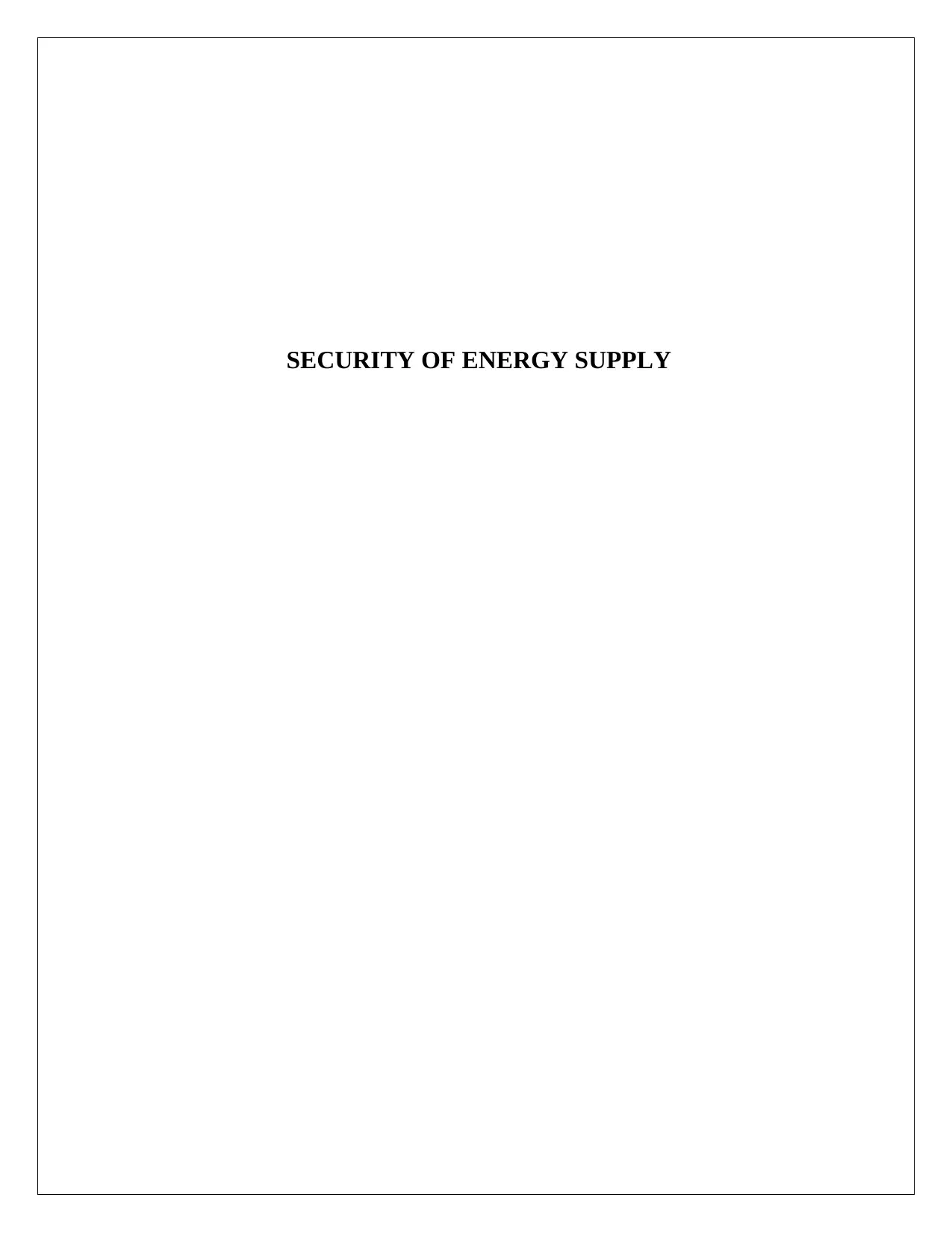
SECURITY OF ENERGY SUPPLY
Paraphrase This Document
Need a fresh take? Get an instant paraphrase of this document with our AI Paraphraser
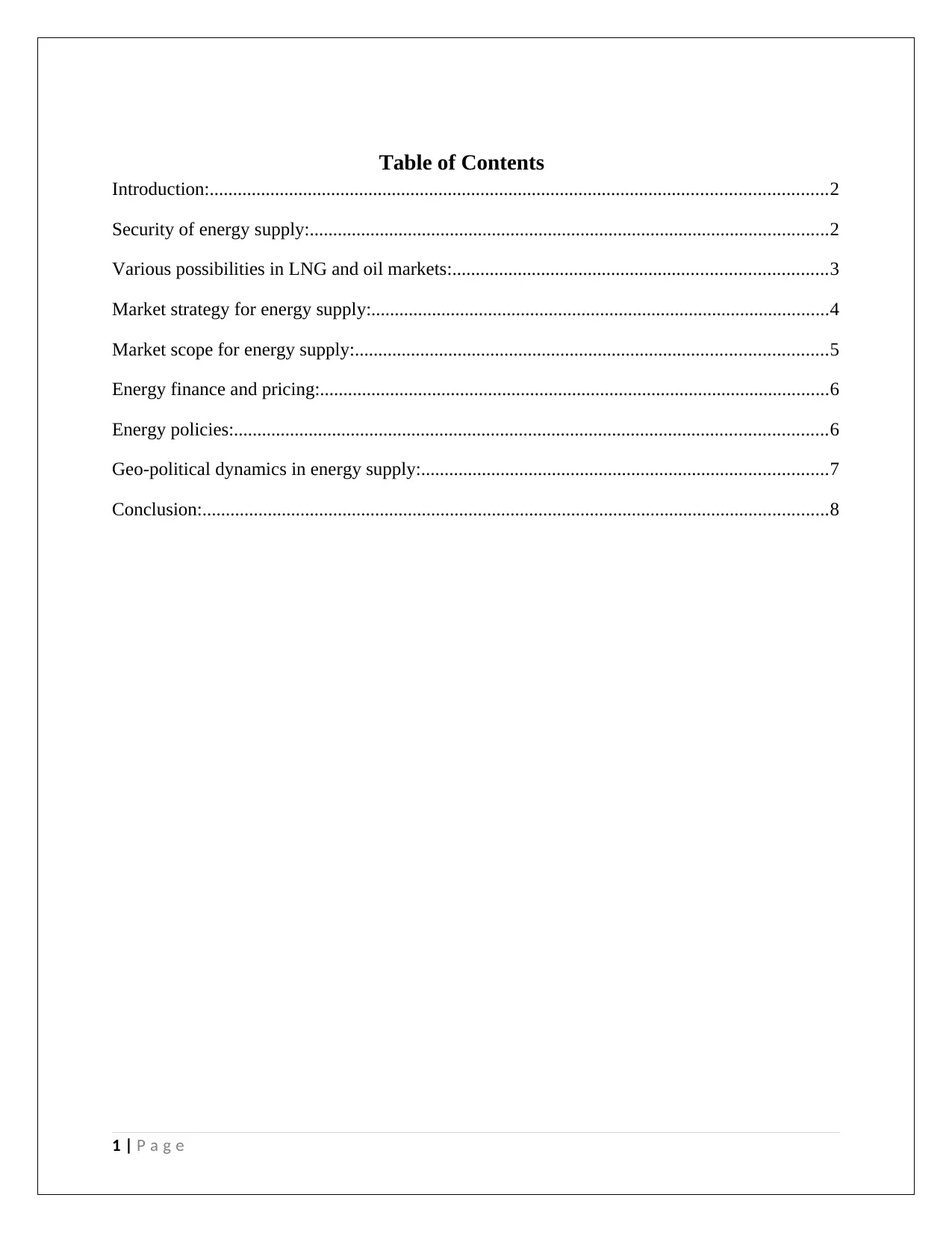
Table of Contents
Introduction:....................................................................................................................................2
Security of energy supply:...............................................................................................................2
Various possibilities in LNG and oil markets:................................................................................3
Market strategy for energy supply:..................................................................................................4
Market scope for energy supply:.....................................................................................................5
Energy finance and pricing:.............................................................................................................6
Energy policies:...............................................................................................................................6
Geo-political dynamics in energy supply:.......................................................................................7
Conclusion:......................................................................................................................................8
1 | P a g e
Introduction:....................................................................................................................................2
Security of energy supply:...............................................................................................................2
Various possibilities in LNG and oil markets:................................................................................3
Market strategy for energy supply:..................................................................................................4
Market scope for energy supply:.....................................................................................................5
Energy finance and pricing:.............................................................................................................6
Energy policies:...............................................................................................................................6
Geo-political dynamics in energy supply:.......................................................................................7
Conclusion:......................................................................................................................................8
1 | P a g e
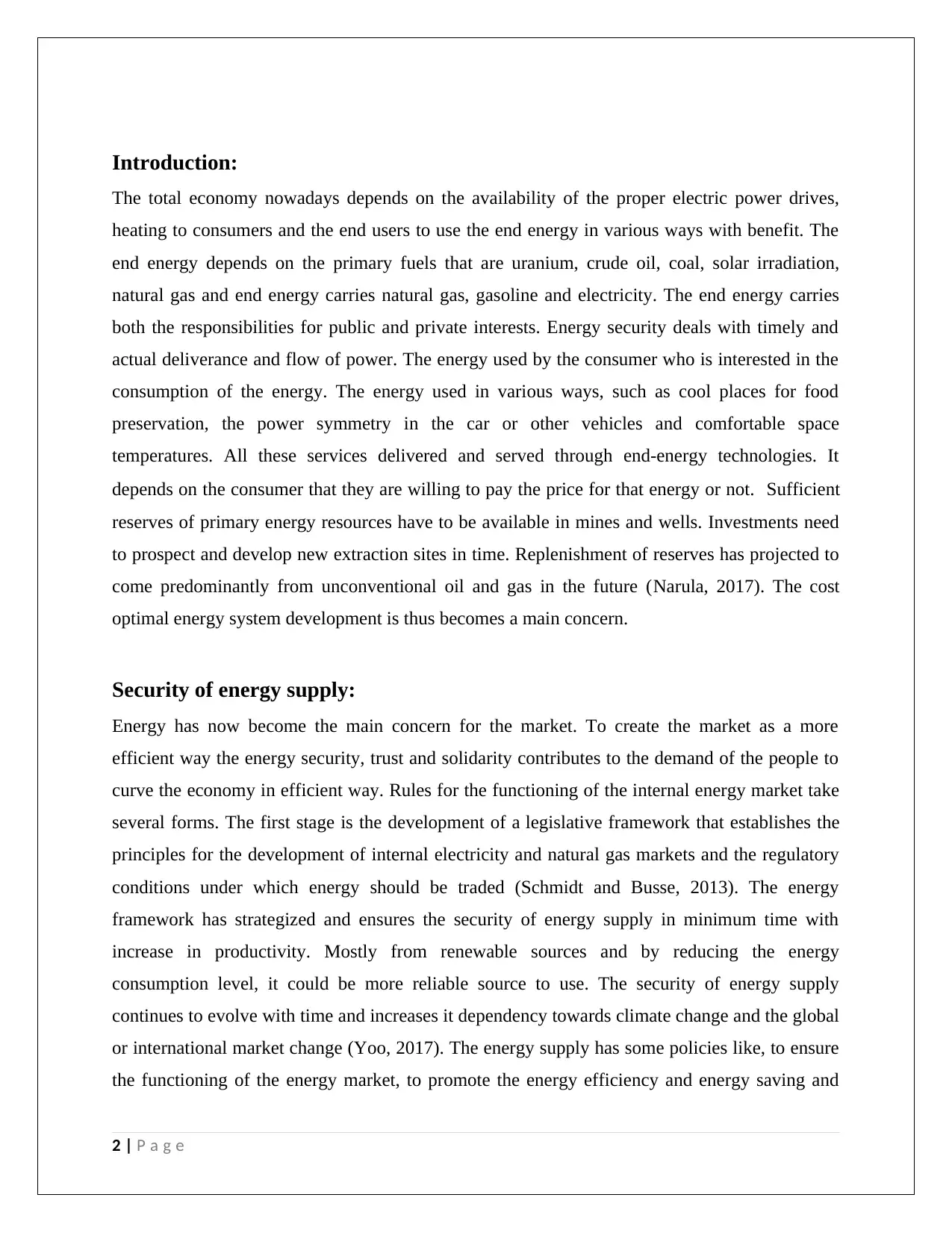
Introduction:
The total economy nowadays depends on the availability of the proper electric power drives,
heating to consumers and the end users to use the end energy in various ways with benefit. The
end energy depends on the primary fuels that are uranium, crude oil, coal, solar irradiation,
natural gas and end energy carries natural gas, gasoline and electricity. The end energy carries
both the responsibilities for public and private interests. Energy security deals with timely and
actual deliverance and flow of power. The energy used by the consumer who is interested in the
consumption of the energy. The energy used in various ways, such as cool places for food
preservation, the power symmetry in the car or other vehicles and comfortable space
temperatures. All these services delivered and served through end-energy technologies. It
depends on the consumer that they are willing to pay the price for that energy or not. Sufficient
reserves of primary energy resources have to be available in mines and wells. Investments need
to prospect and develop new extraction sites in time. Replenishment of reserves has projected to
come predominantly from unconventional oil and gas in the future (Narula, 2017). The cost
optimal energy system development is thus becomes a main concern.
Security of energy supply:
Energy has now become the main concern for the market. To create the market as a more
efficient way the energy security, trust and solidarity contributes to the demand of the people to
curve the economy in efficient way. Rules for the functioning of the internal energy market take
several forms. The first stage is the development of a legislative framework that establishes the
principles for the development of internal electricity and natural gas markets and the regulatory
conditions under which energy should be traded (Schmidt and Busse, 2013). The energy
framework has strategized and ensures the security of energy supply in minimum time with
increase in productivity. Mostly from renewable sources and by reducing the energy
consumption level, it could be more reliable source to use. The security of energy supply
continues to evolve with time and increases it dependency towards climate change and the global
or international market change (Yoo, 2017). The energy supply has some policies like, to ensure
the functioning of the energy market, to promote the energy efficiency and energy saving and
2 | P a g e
The total economy nowadays depends on the availability of the proper electric power drives,
heating to consumers and the end users to use the end energy in various ways with benefit. The
end energy depends on the primary fuels that are uranium, crude oil, coal, solar irradiation,
natural gas and end energy carries natural gas, gasoline and electricity. The end energy carries
both the responsibilities for public and private interests. Energy security deals with timely and
actual deliverance and flow of power. The energy used by the consumer who is interested in the
consumption of the energy. The energy used in various ways, such as cool places for food
preservation, the power symmetry in the car or other vehicles and comfortable space
temperatures. All these services delivered and served through end-energy technologies. It
depends on the consumer that they are willing to pay the price for that energy or not. Sufficient
reserves of primary energy resources have to be available in mines and wells. Investments need
to prospect and develop new extraction sites in time. Replenishment of reserves has projected to
come predominantly from unconventional oil and gas in the future (Narula, 2017). The cost
optimal energy system development is thus becomes a main concern.
Security of energy supply:
Energy has now become the main concern for the market. To create the market as a more
efficient way the energy security, trust and solidarity contributes to the demand of the people to
curve the economy in efficient way. Rules for the functioning of the internal energy market take
several forms. The first stage is the development of a legislative framework that establishes the
principles for the development of internal electricity and natural gas markets and the regulatory
conditions under which energy should be traded (Schmidt and Busse, 2013). The energy
framework has strategized and ensures the security of energy supply in minimum time with
increase in productivity. Mostly from renewable sources and by reducing the energy
consumption level, it could be more reliable source to use. The security of energy supply
continues to evolve with time and increases it dependency towards climate change and the global
or international market change (Yoo, 2017). The energy supply has some policies like, to ensure
the functioning of the energy market, to promote the energy efficiency and energy saving and
2 | P a g e
⊘ This is a preview!⊘
Do you want full access?
Subscribe today to unlock all pages.

Trusted by 1+ million students worldwide
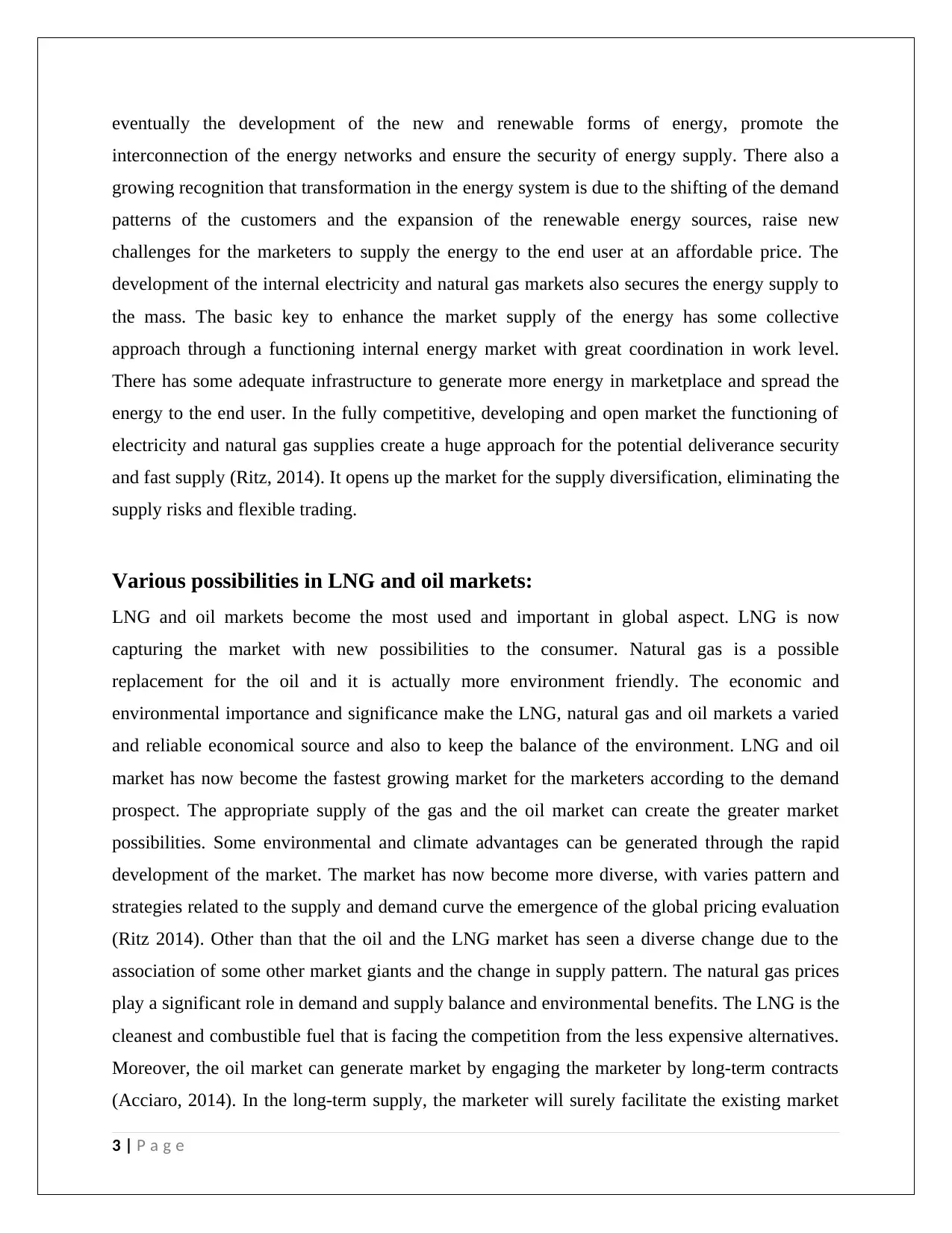
eventually the development of the new and renewable forms of energy, promote the
interconnection of the energy networks and ensure the security of energy supply. There also a
growing recognition that transformation in the energy system is due to the shifting of the demand
patterns of the customers and the expansion of the renewable energy sources, raise new
challenges for the marketers to supply the energy to the end user at an affordable price. The
development of the internal electricity and natural gas markets also secures the energy supply to
the mass. The basic key to enhance the market supply of the energy has some collective
approach through a functioning internal energy market with great coordination in work level.
There has some adequate infrastructure to generate more energy in marketplace and spread the
energy to the end user. In the fully competitive, developing and open market the functioning of
electricity and natural gas supplies create a huge approach for the potential deliverance security
and fast supply (Ritz, 2014). It opens up the market for the supply diversification, eliminating the
supply risks and flexible trading.
Various possibilities in LNG and oil markets:
LNG and oil markets become the most used and important in global aspect. LNG is now
capturing the market with new possibilities to the consumer. Natural gas is a possible
replacement for the oil and it is actually more environment friendly. The economic and
environmental importance and significance make the LNG, natural gas and oil markets a varied
and reliable economical source and also to keep the balance of the environment. LNG and oil
market has now become the fastest growing market for the marketers according to the demand
prospect. The appropriate supply of the gas and the oil market can create the greater market
possibilities. Some environmental and climate advantages can be generated through the rapid
development of the market. The market has now become more diverse, with varies pattern and
strategies related to the supply and demand curve the emergence of the global pricing evaluation
(Ritz 2014). Other than that the oil and the LNG market has seen a diverse change due to the
association of some other market giants and the change in supply pattern. The natural gas prices
play a significant role in demand and supply balance and environmental benefits. The LNG is the
cleanest and combustible fuel that is facing the competition from the less expensive alternatives.
Moreover, the oil market can generate market by engaging the marketer by long-term contracts
(Acciaro, 2014). In the long-term supply, the marketer will surely facilitate the existing market
3 | P a g e
interconnection of the energy networks and ensure the security of energy supply. There also a
growing recognition that transformation in the energy system is due to the shifting of the demand
patterns of the customers and the expansion of the renewable energy sources, raise new
challenges for the marketers to supply the energy to the end user at an affordable price. The
development of the internal electricity and natural gas markets also secures the energy supply to
the mass. The basic key to enhance the market supply of the energy has some collective
approach through a functioning internal energy market with great coordination in work level.
There has some adequate infrastructure to generate more energy in marketplace and spread the
energy to the end user. In the fully competitive, developing and open market the functioning of
electricity and natural gas supplies create a huge approach for the potential deliverance security
and fast supply (Ritz, 2014). It opens up the market for the supply diversification, eliminating the
supply risks and flexible trading.
Various possibilities in LNG and oil markets:
LNG and oil markets become the most used and important in global aspect. LNG is now
capturing the market with new possibilities to the consumer. Natural gas is a possible
replacement for the oil and it is actually more environment friendly. The economic and
environmental importance and significance make the LNG, natural gas and oil markets a varied
and reliable economical source and also to keep the balance of the environment. LNG and oil
market has now become the fastest growing market for the marketers according to the demand
prospect. The appropriate supply of the gas and the oil market can create the greater market
possibilities. Some environmental and climate advantages can be generated through the rapid
development of the market. The market has now become more diverse, with varies pattern and
strategies related to the supply and demand curve the emergence of the global pricing evaluation
(Ritz 2014). Other than that the oil and the LNG market has seen a diverse change due to the
association of some other market giants and the change in supply pattern. The natural gas prices
play a significant role in demand and supply balance and environmental benefits. The LNG is the
cleanest and combustible fuel that is facing the competition from the less expensive alternatives.
Moreover, the oil market can generate market by engaging the marketer by long-term contracts
(Acciaro, 2014). In the long-term supply, the marketer will surely facilitate the existing market
3 | P a g e
Paraphrase This Document
Need a fresh take? Get an instant paraphrase of this document with our AI Paraphraser
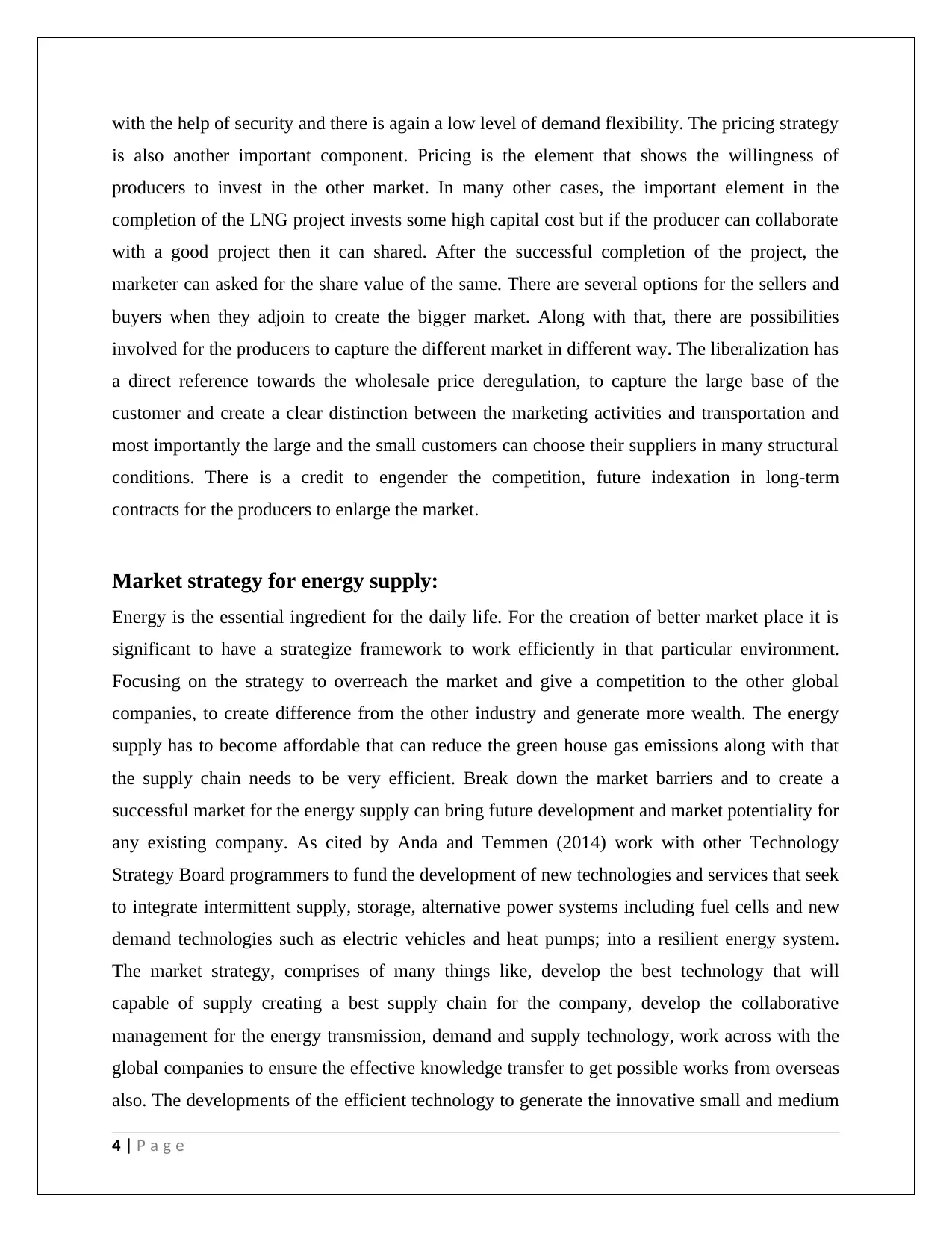
with the help of security and there is again a low level of demand flexibility. The pricing strategy
is also another important component. Pricing is the element that shows the willingness of
producers to invest in the other market. In many other cases, the important element in the
completion of the LNG project invests some high capital cost but if the producer can collaborate
with a good project then it can shared. After the successful completion of the project, the
marketer can asked for the share value of the same. There are several options for the sellers and
buyers when they adjoin to create the bigger market. Along with that, there are possibilities
involved for the producers to capture the different market in different way. The liberalization has
a direct reference towards the wholesale price deregulation, to capture the large base of the
customer and create a clear distinction between the marketing activities and transportation and
most importantly the large and the small customers can choose their suppliers in many structural
conditions. There is a credit to engender the competition, future indexation in long-term
contracts for the producers to enlarge the market.
Market strategy for energy supply:
Energy is the essential ingredient for the daily life. For the creation of better market place it is
significant to have a strategize framework to work efficiently in that particular environment.
Focusing on the strategy to overreach the market and give a competition to the other global
companies, to create difference from the other industry and generate more wealth. The energy
supply has to become affordable that can reduce the green house gas emissions along with that
the supply chain needs to be very efficient. Break down the market barriers and to create a
successful market for the energy supply can bring future development and market potentiality for
any existing company. As cited by Anda and Temmen (2014) work with other Technology
Strategy Board programmers to fund the development of new technologies and services that seek
to integrate intermittent supply, storage, alternative power systems including fuel cells and new
demand technologies such as electric vehicles and heat pumps; into a resilient energy system.
The market strategy, comprises of many things like, develop the best technology that will
capable of supply creating a best supply chain for the company, develop the collaborative
management for the energy transmission, demand and supply technology, work across with the
global companies to ensure the effective knowledge transfer to get possible works from overseas
also. The developments of the efficient technology to generate the innovative small and medium
4 | P a g e
is also another important component. Pricing is the element that shows the willingness of
producers to invest in the other market. In many other cases, the important element in the
completion of the LNG project invests some high capital cost but if the producer can collaborate
with a good project then it can shared. After the successful completion of the project, the
marketer can asked for the share value of the same. There are several options for the sellers and
buyers when they adjoin to create the bigger market. Along with that, there are possibilities
involved for the producers to capture the different market in different way. The liberalization has
a direct reference towards the wholesale price deregulation, to capture the large base of the
customer and create a clear distinction between the marketing activities and transportation and
most importantly the large and the small customers can choose their suppliers in many structural
conditions. There is a credit to engender the competition, future indexation in long-term
contracts for the producers to enlarge the market.
Market strategy for energy supply:
Energy is the essential ingredient for the daily life. For the creation of better market place it is
significant to have a strategize framework to work efficiently in that particular environment.
Focusing on the strategy to overreach the market and give a competition to the other global
companies, to create difference from the other industry and generate more wealth. The energy
supply has to become affordable that can reduce the green house gas emissions along with that
the supply chain needs to be very efficient. Break down the market barriers and to create a
successful market for the energy supply can bring future development and market potentiality for
any existing company. As cited by Anda and Temmen (2014) work with other Technology
Strategy Board programmers to fund the development of new technologies and services that seek
to integrate intermittent supply, storage, alternative power systems including fuel cells and new
demand technologies such as electric vehicles and heat pumps; into a resilient energy system.
The market strategy, comprises of many things like, develop the best technology that will
capable of supply creating a best supply chain for the company, develop the collaborative
management for the energy transmission, demand and supply technology, work across with the
global companies to ensure the effective knowledge transfer to get possible works from overseas
also. The developments of the efficient technology to generate the innovative small and medium
4 | P a g e
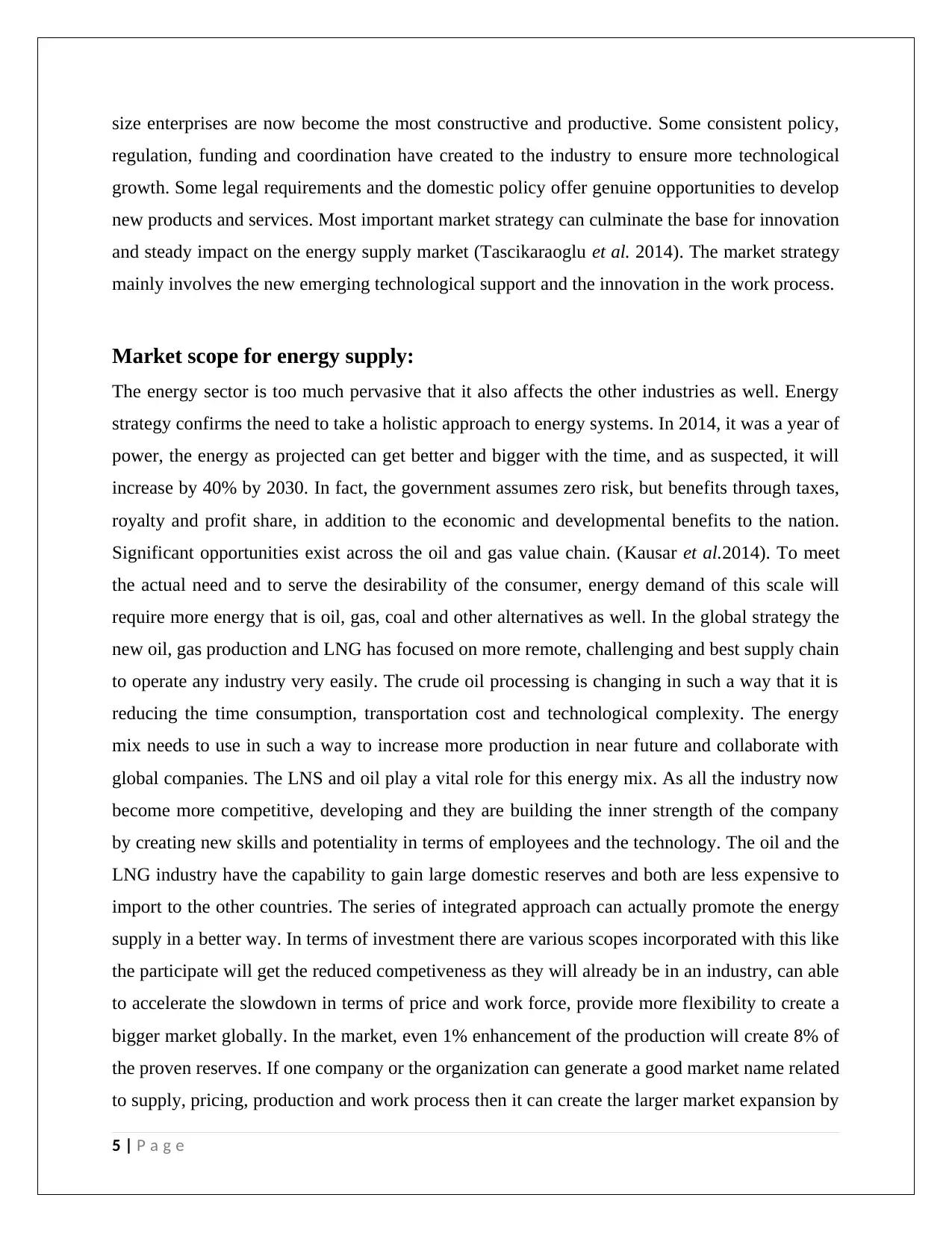
size enterprises are now become the most constructive and productive. Some consistent policy,
regulation, funding and coordination have created to the industry to ensure more technological
growth. Some legal requirements and the domestic policy offer genuine opportunities to develop
new products and services. Most important market strategy can culminate the base for innovation
and steady impact on the energy supply market (Tascikaraoglu et al. 2014). The market strategy
mainly involves the new emerging technological support and the innovation in the work process.
Market scope for energy supply:
The energy sector is too much pervasive that it also affects the other industries as well. Energy
strategy confirms the need to take a holistic approach to energy systems. In 2014, it was a year of
power, the energy as projected can get better and bigger with the time, and as suspected, it will
increase by 40% by 2030. In fact, the government assumes zero risk, but benefits through taxes,
royalty and profit share, in addition to the economic and developmental benefits to the nation.
Significant opportunities exist across the oil and gas value chain. (Kausar et al.2014). To meet
the actual need and to serve the desirability of the consumer, energy demand of this scale will
require more energy that is oil, gas, coal and other alternatives as well. In the global strategy the
new oil, gas production and LNG has focused on more remote, challenging and best supply chain
to operate any industry very easily. The crude oil processing is changing in such a way that it is
reducing the time consumption, transportation cost and technological complexity. The energy
mix needs to use in such a way to increase more production in near future and collaborate with
global companies. The LNS and oil play a vital role for this energy mix. As all the industry now
become more competitive, developing and they are building the inner strength of the company
by creating new skills and potentiality in terms of employees and the technology. The oil and the
LNG industry have the capability to gain large domestic reserves and both are less expensive to
import to the other countries. The series of integrated approach can actually promote the energy
supply in a better way. In terms of investment there are various scopes incorporated with this like
the participate will get the reduced competiveness as they will already be in an industry, can able
to accelerate the slowdown in terms of price and work force, provide more flexibility to create a
bigger market globally. In the market, even 1% enhancement of the production will create 8% of
the proven reserves. If one company or the organization can generate a good market name related
to supply, pricing, production and work process then it can create the larger market expansion by
5 | P a g e
regulation, funding and coordination have created to the industry to ensure more technological
growth. Some legal requirements and the domestic policy offer genuine opportunities to develop
new products and services. Most important market strategy can culminate the base for innovation
and steady impact on the energy supply market (Tascikaraoglu et al. 2014). The market strategy
mainly involves the new emerging technological support and the innovation in the work process.
Market scope for energy supply:
The energy sector is too much pervasive that it also affects the other industries as well. Energy
strategy confirms the need to take a holistic approach to energy systems. In 2014, it was a year of
power, the energy as projected can get better and bigger with the time, and as suspected, it will
increase by 40% by 2030. In fact, the government assumes zero risk, but benefits through taxes,
royalty and profit share, in addition to the economic and developmental benefits to the nation.
Significant opportunities exist across the oil and gas value chain. (Kausar et al.2014). To meet
the actual need and to serve the desirability of the consumer, energy demand of this scale will
require more energy that is oil, gas, coal and other alternatives as well. In the global strategy the
new oil, gas production and LNG has focused on more remote, challenging and best supply chain
to operate any industry very easily. The crude oil processing is changing in such a way that it is
reducing the time consumption, transportation cost and technological complexity. The energy
mix needs to use in such a way to increase more production in near future and collaborate with
global companies. The LNS and oil play a vital role for this energy mix. As all the industry now
become more competitive, developing and they are building the inner strength of the company
by creating new skills and potentiality in terms of employees and the technology. The oil and the
LNG industry have the capability to gain large domestic reserves and both are less expensive to
import to the other countries. The series of integrated approach can actually promote the energy
supply in a better way. In terms of investment there are various scopes incorporated with this like
the participate will get the reduced competiveness as they will already be in an industry, can able
to accelerate the slowdown in terms of price and work force, provide more flexibility to create a
bigger market globally. In the market, even 1% enhancement of the production will create 8% of
the proven reserves. If one company or the organization can generate a good market name related
to supply, pricing, production and work process then it can create the larger market expansion by
5 | P a g e
⊘ This is a preview!⊘
Do you want full access?
Subscribe today to unlock all pages.

Trusted by 1+ million students worldwide
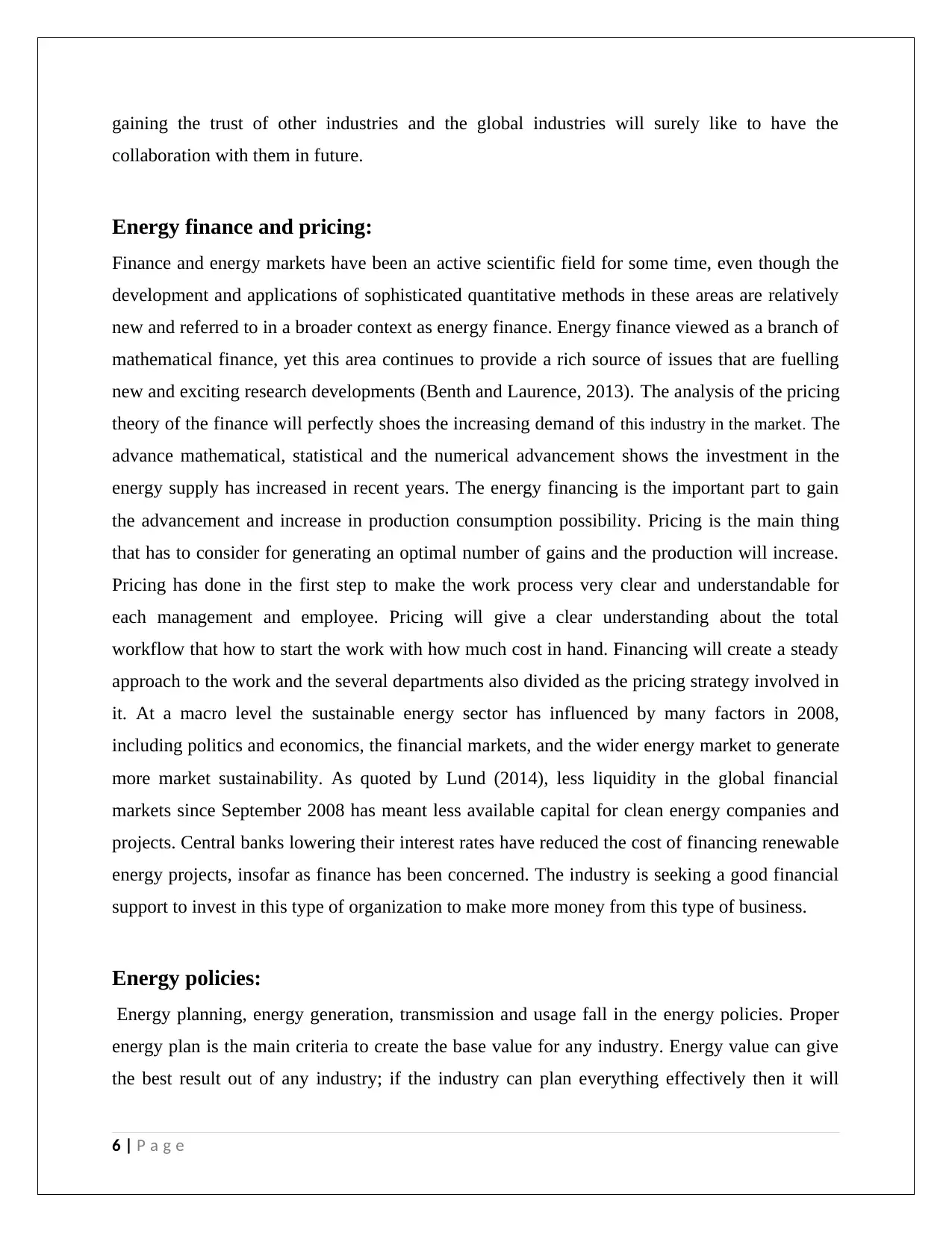
gaining the trust of other industries and the global industries will surely like to have the
collaboration with them in future.
Energy finance and pricing:
Finance and energy markets have been an active scientific field for some time, even though the
development and applications of sophisticated quantitative methods in these areas are relatively
new and referred to in a broader context as energy finance. Energy finance viewed as a branch of
mathematical finance, yet this area continues to provide a rich source of issues that are fuelling
new and exciting research developments (Benth and Laurence, 2013). The analysis of the pricing
theory of the finance will perfectly shoes the increasing demand of this industry in the market. The
advance mathematical, statistical and the numerical advancement shows the investment in the
energy supply has increased in recent years. The energy financing is the important part to gain
the advancement and increase in production consumption possibility. Pricing is the main thing
that has to consider for generating an optimal number of gains and the production will increase.
Pricing has done in the first step to make the work process very clear and understandable for
each management and employee. Pricing will give a clear understanding about the total
workflow that how to start the work with how much cost in hand. Financing will create a steady
approach to the work and the several departments also divided as the pricing strategy involved in
it. At a macro level the sustainable energy sector has influenced by many factors in 2008,
including politics and economics, the financial markets, and the wider energy market to generate
more market sustainability. As quoted by Lund (2014), less liquidity in the global financial
markets since September 2008 has meant less available capital for clean energy companies and
projects. Central banks lowering their interest rates have reduced the cost of financing renewable
energy projects, insofar as finance has been concerned. The industry is seeking a good financial
support to invest in this type of organization to make more money from this type of business.
Energy policies:
Energy planning, energy generation, transmission and usage fall in the energy policies. Proper
energy plan is the main criteria to create the base value for any industry. Energy value can give
the best result out of any industry; if the industry can plan everything effectively then it will
6 | P a g e
collaboration with them in future.
Energy finance and pricing:
Finance and energy markets have been an active scientific field for some time, even though the
development and applications of sophisticated quantitative methods in these areas are relatively
new and referred to in a broader context as energy finance. Energy finance viewed as a branch of
mathematical finance, yet this area continues to provide a rich source of issues that are fuelling
new and exciting research developments (Benth and Laurence, 2013). The analysis of the pricing
theory of the finance will perfectly shoes the increasing demand of this industry in the market. The
advance mathematical, statistical and the numerical advancement shows the investment in the
energy supply has increased in recent years. The energy financing is the important part to gain
the advancement and increase in production consumption possibility. Pricing is the main thing
that has to consider for generating an optimal number of gains and the production will increase.
Pricing has done in the first step to make the work process very clear and understandable for
each management and employee. Pricing will give a clear understanding about the total
workflow that how to start the work with how much cost in hand. Financing will create a steady
approach to the work and the several departments also divided as the pricing strategy involved in
it. At a macro level the sustainable energy sector has influenced by many factors in 2008,
including politics and economics, the financial markets, and the wider energy market to generate
more market sustainability. As quoted by Lund (2014), less liquidity in the global financial
markets since September 2008 has meant less available capital for clean energy companies and
projects. Central banks lowering their interest rates have reduced the cost of financing renewable
energy projects, insofar as finance has been concerned. The industry is seeking a good financial
support to invest in this type of organization to make more money from this type of business.
Energy policies:
Energy planning, energy generation, transmission and usage fall in the energy policies. Proper
energy plan is the main criteria to create the base value for any industry. Energy value can give
the best result out of any industry; if the industry can plan everything effectively then it will
6 | P a g e
Paraphrase This Document
Need a fresh take? Get an instant paraphrase of this document with our AI Paraphraser
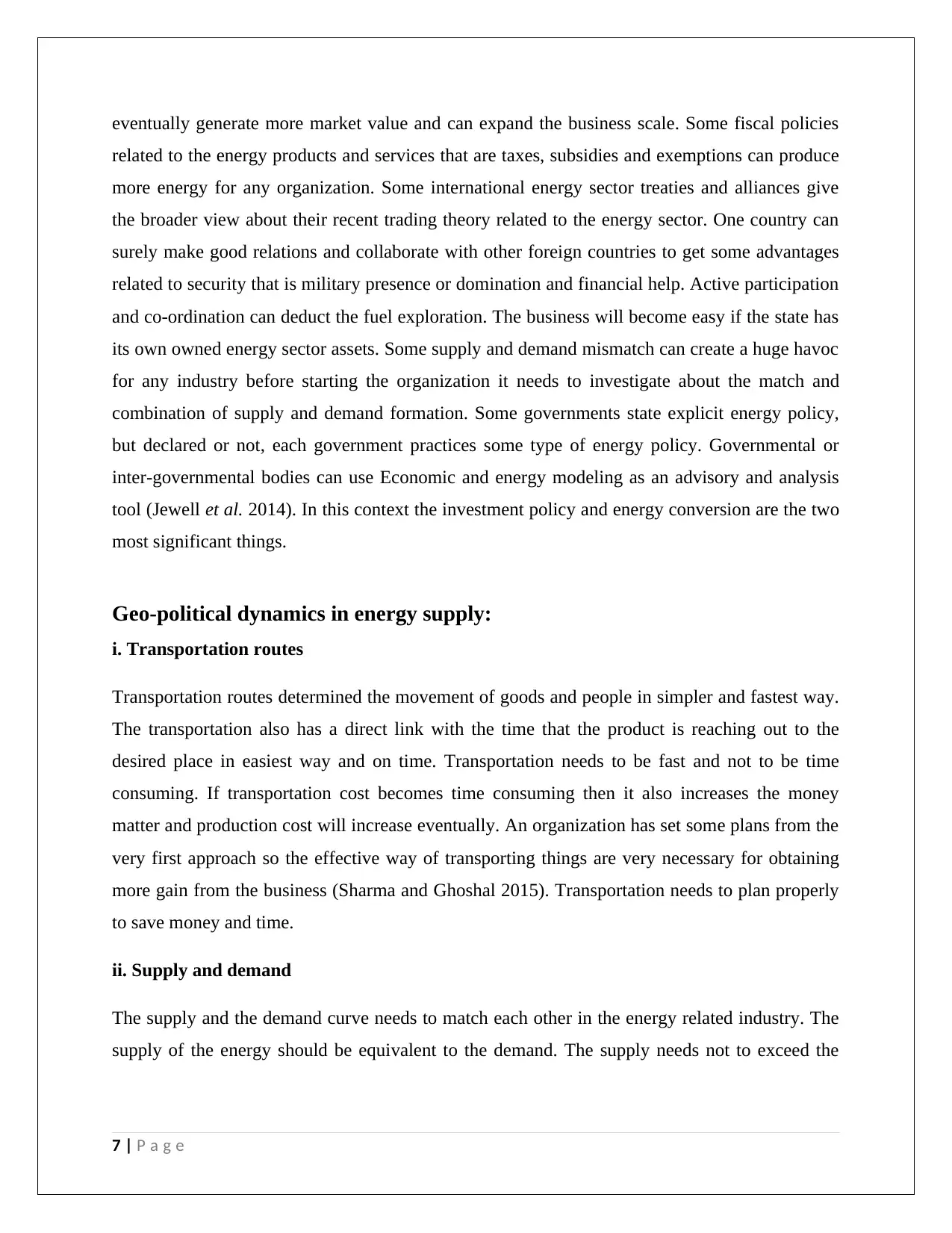
eventually generate more market value and can expand the business scale. Some fiscal policies
related to the energy products and services that are taxes, subsidies and exemptions can produce
more energy for any organization. Some international energy sector treaties and alliances give
the broader view about their recent trading theory related to the energy sector. One country can
surely make good relations and collaborate with other foreign countries to get some advantages
related to security that is military presence or domination and financial help. Active participation
and co-ordination can deduct the fuel exploration. The business will become easy if the state has
its own owned energy sector assets. Some supply and demand mismatch can create a huge havoc
for any industry before starting the organization it needs to investigate about the match and
combination of supply and demand formation. Some governments state explicit energy policy,
but declared or not, each government practices some type of energy policy. Governmental or
inter-governmental bodies can use Economic and energy modeling as an advisory and analysis
tool (Jewell et al. 2014). In this context the investment policy and energy conversion are the two
most significant things.
Geo-political dynamics in energy supply:
i. Transportation routes
Transportation routes determined the movement of goods and people in simpler and fastest way.
The transportation also has a direct link with the time that the product is reaching out to the
desired place in easiest way and on time. Transportation needs to be fast and not to be time
consuming. If transportation cost becomes time consuming then it also increases the money
matter and production cost will increase eventually. An organization has set some plans from the
very first approach so the effective way of transporting things are very necessary for obtaining
more gain from the business (Sharma and Ghoshal 2015). Transportation needs to plan properly
to save money and time.
ii. Supply and demand
The supply and the demand curve needs to match each other in the energy related industry. The
supply of the energy should be equivalent to the demand. The supply needs not to exceed the
7 | P a g e
related to the energy products and services that are taxes, subsidies and exemptions can produce
more energy for any organization. Some international energy sector treaties and alliances give
the broader view about their recent trading theory related to the energy sector. One country can
surely make good relations and collaborate with other foreign countries to get some advantages
related to security that is military presence or domination and financial help. Active participation
and co-ordination can deduct the fuel exploration. The business will become easy if the state has
its own owned energy sector assets. Some supply and demand mismatch can create a huge havoc
for any industry before starting the organization it needs to investigate about the match and
combination of supply and demand formation. Some governments state explicit energy policy,
but declared or not, each government practices some type of energy policy. Governmental or
inter-governmental bodies can use Economic and energy modeling as an advisory and analysis
tool (Jewell et al. 2014). In this context the investment policy and energy conversion are the two
most significant things.
Geo-political dynamics in energy supply:
i. Transportation routes
Transportation routes determined the movement of goods and people in simpler and fastest way.
The transportation also has a direct link with the time that the product is reaching out to the
desired place in easiest way and on time. Transportation needs to be fast and not to be time
consuming. If transportation cost becomes time consuming then it also increases the money
matter and production cost will increase eventually. An organization has set some plans from the
very first approach so the effective way of transporting things are very necessary for obtaining
more gain from the business (Sharma and Ghoshal 2015). Transportation needs to plan properly
to save money and time.
ii. Supply and demand
The supply and the demand curve needs to match each other in the energy related industry. The
supply of the energy should be equivalent to the demand. The supply needs not to exceed the
7 | P a g e
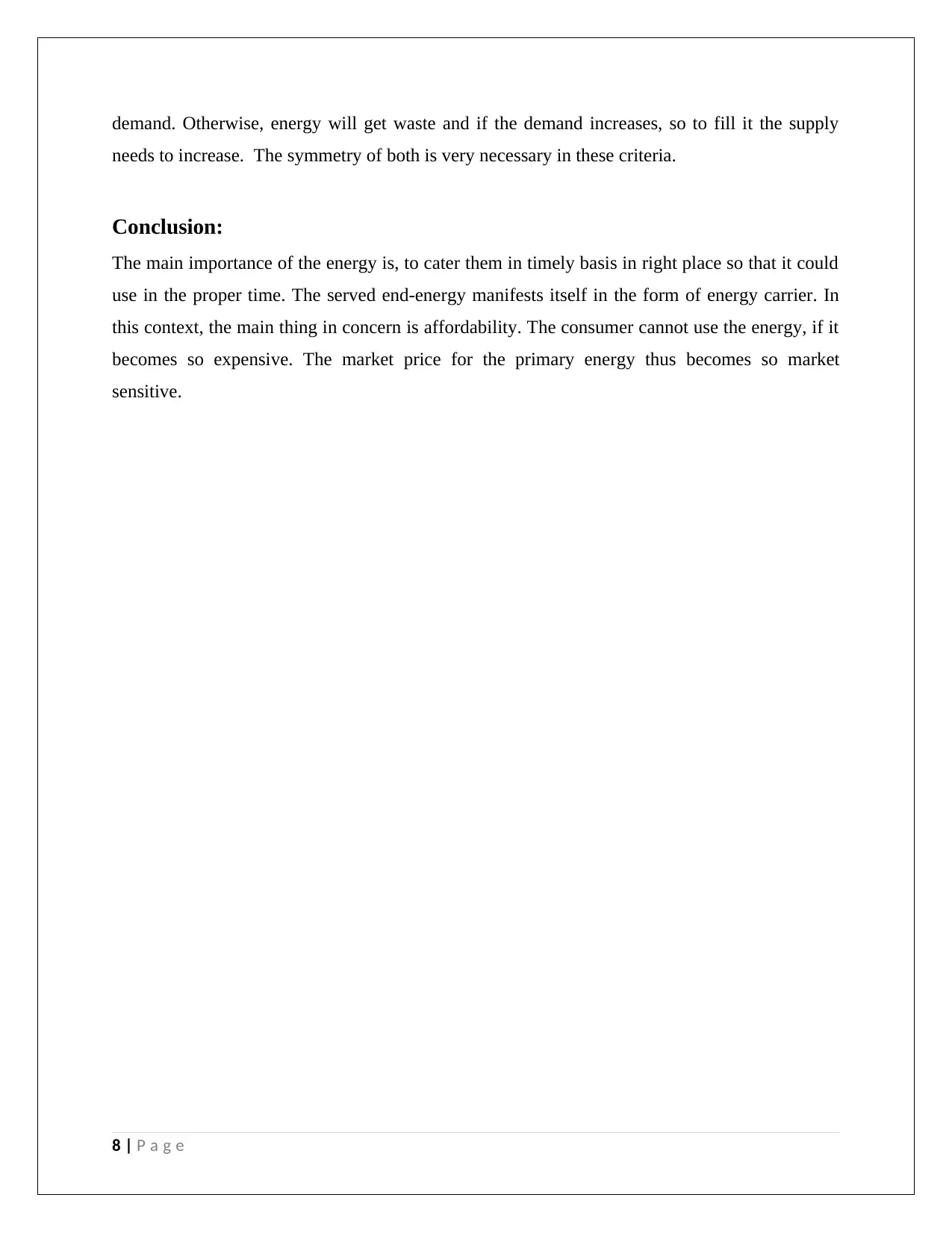
demand. Otherwise, energy will get waste and if the demand increases, so to fill it the supply
needs to increase. The symmetry of both is very necessary in these criteria.
Conclusion:
The main importance of the energy is, to cater them in timely basis in right place so that it could
use in the proper time. The served end-energy manifests itself in the form of energy carrier. In
this context, the main thing in concern is affordability. The consumer cannot use the energy, if it
becomes so expensive. The market price for the primary energy thus becomes so market
sensitive.
8 | P a g e
needs to increase. The symmetry of both is very necessary in these criteria.
Conclusion:
The main importance of the energy is, to cater them in timely basis in right place so that it could
use in the proper time. The served end-energy manifests itself in the form of energy carrier. In
this context, the main thing in concern is affordability. The consumer cannot use the energy, if it
becomes so expensive. The market price for the primary energy thus becomes so market
sensitive.
8 | P a g e
⊘ This is a preview!⊘
Do you want full access?
Subscribe today to unlock all pages.

Trusted by 1+ million students worldwide
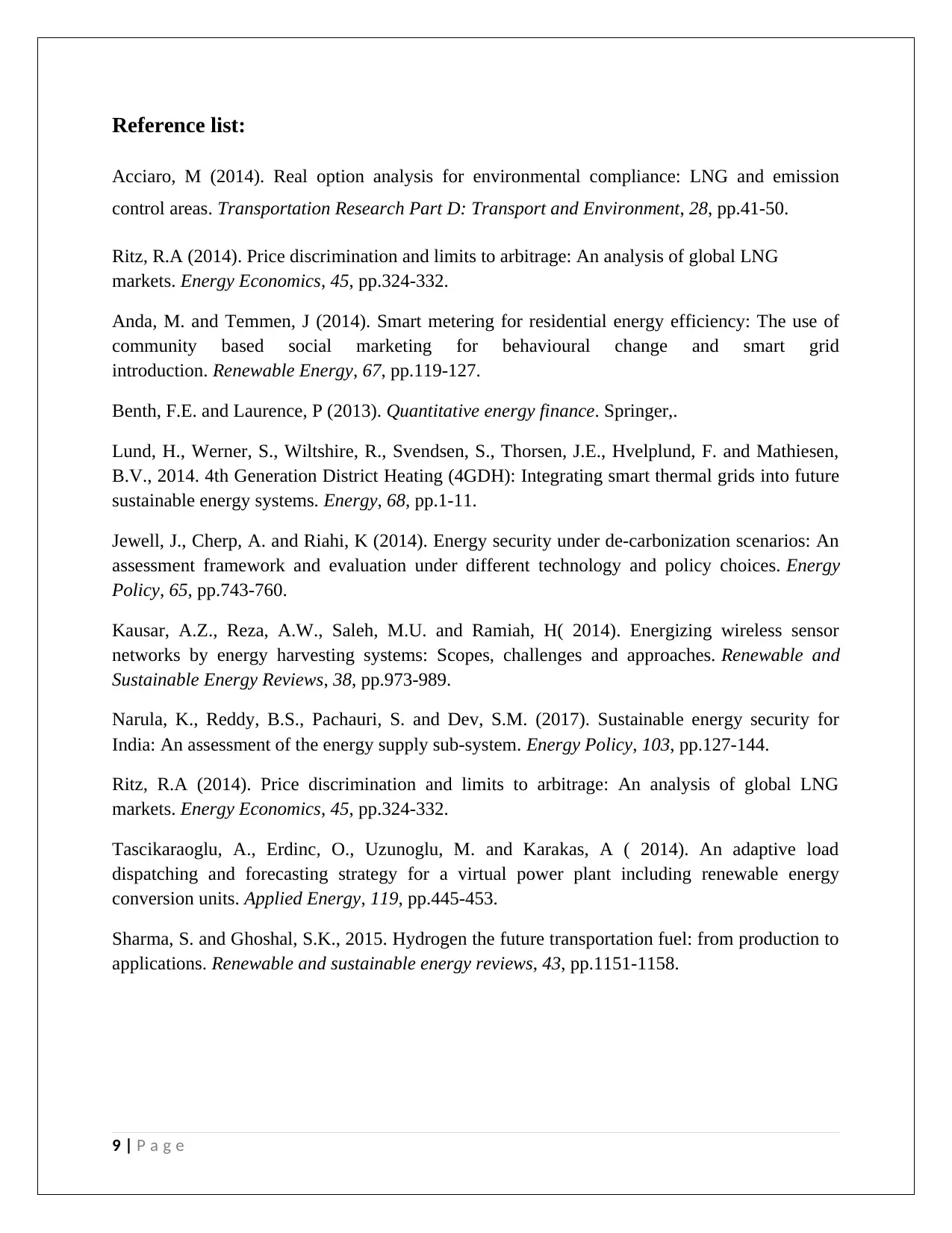
Reference list:
Acciaro, M (2014). Real option analysis for environmental compliance: LNG and emission
control areas. Transportation Research Part D: Transport and Environment, 28, pp.41-50.
Ritz, R.A (2014). Price discrimination and limits to arbitrage: An analysis of global LNG
markets. Energy Economics, 45, pp.324-332.
Anda, M. and Temmen, J (2014). Smart metering for residential energy efficiency: The use of
community based social marketing for behavioural change and smart grid
introduction. Renewable Energy, 67, pp.119-127.
Benth, F.E. and Laurence, P (2013). Quantitative energy finance. Springer,.
Lund, H., Werner, S., Wiltshire, R., Svendsen, S., Thorsen, J.E., Hvelplund, F. and Mathiesen,
B.V., 2014. 4th Generation District Heating (4GDH): Integrating smart thermal grids into future
sustainable energy systems. Energy, 68, pp.1-11.
Jewell, J., Cherp, A. and Riahi, K (2014). Energy security under de-carbonization scenarios: An
assessment framework and evaluation under different technology and policy choices. Energy
Policy, 65, pp.743-760.
Kausar, A.Z., Reza, A.W., Saleh, M.U. and Ramiah, H( 2014). Energizing wireless sensor
networks by energy harvesting systems: Scopes, challenges and approaches. Renewable and
Sustainable Energy Reviews, 38, pp.973-989.
Narula, K., Reddy, B.S., Pachauri, S. and Dev, S.M. (2017). Sustainable energy security for
India: An assessment of the energy supply sub-system. Energy Policy, 103, pp.127-144.
Ritz, R.A (2014). Price discrimination and limits to arbitrage: An analysis of global LNG
markets. Energy Economics, 45, pp.324-332.
Tascikaraoglu, A., Erdinc, O., Uzunoglu, M. and Karakas, A ( 2014). An adaptive load
dispatching and forecasting strategy for a virtual power plant including renewable energy
conversion units. Applied Energy, 119, pp.445-453.
Sharma, S. and Ghoshal, S.K., 2015. Hydrogen the future transportation fuel: from production to
applications. Renewable and sustainable energy reviews, 43, pp.1151-1158.
9 | P a g e
Acciaro, M (2014). Real option analysis for environmental compliance: LNG and emission
control areas. Transportation Research Part D: Transport and Environment, 28, pp.41-50.
Ritz, R.A (2014). Price discrimination and limits to arbitrage: An analysis of global LNG
markets. Energy Economics, 45, pp.324-332.
Anda, M. and Temmen, J (2014). Smart metering for residential energy efficiency: The use of
community based social marketing for behavioural change and smart grid
introduction. Renewable Energy, 67, pp.119-127.
Benth, F.E. and Laurence, P (2013). Quantitative energy finance. Springer,.
Lund, H., Werner, S., Wiltshire, R., Svendsen, S., Thorsen, J.E., Hvelplund, F. and Mathiesen,
B.V., 2014. 4th Generation District Heating (4GDH): Integrating smart thermal grids into future
sustainable energy systems. Energy, 68, pp.1-11.
Jewell, J., Cherp, A. and Riahi, K (2014). Energy security under de-carbonization scenarios: An
assessment framework and evaluation under different technology and policy choices. Energy
Policy, 65, pp.743-760.
Kausar, A.Z., Reza, A.W., Saleh, M.U. and Ramiah, H( 2014). Energizing wireless sensor
networks by energy harvesting systems: Scopes, challenges and approaches. Renewable and
Sustainable Energy Reviews, 38, pp.973-989.
Narula, K., Reddy, B.S., Pachauri, S. and Dev, S.M. (2017). Sustainable energy security for
India: An assessment of the energy supply sub-system. Energy Policy, 103, pp.127-144.
Ritz, R.A (2014). Price discrimination and limits to arbitrage: An analysis of global LNG
markets. Energy Economics, 45, pp.324-332.
Tascikaraoglu, A., Erdinc, O., Uzunoglu, M. and Karakas, A ( 2014). An adaptive load
dispatching and forecasting strategy for a virtual power plant including renewable energy
conversion units. Applied Energy, 119, pp.445-453.
Sharma, S. and Ghoshal, S.K., 2015. Hydrogen the future transportation fuel: from production to
applications. Renewable and sustainable energy reviews, 43, pp.1151-1158.
9 | P a g e
1 out of 10
Related Documents
Your All-in-One AI-Powered Toolkit for Academic Success.
+13062052269
info@desklib.com
Available 24*7 on WhatsApp / Email
![[object Object]](/_next/static/media/star-bottom.7253800d.svg)
Unlock your academic potential
Copyright © 2020–2025 A2Z Services. All Rights Reserved. Developed and managed by ZUCOL.




![Energy Security: Regional Dimensions Essay - [University Name]](/_next/image/?url=https%3A%2F%2Fdesklib.com%2Fmedia%2Fimages%2Fda%2F83117328299f4e9da5664a7fcb7634cb.jpg&w=256&q=75)
